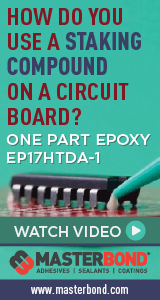|

|
|
| Ask the Experts | |||||||
|
|||||||
|
March 27, 2013 - Updated March 20, 2013 - Originally Posted Standards for Pin-in-PasteWhat is the recommended plated hole to pin ration for pin-in-paste? What is the standard for pin-in-paste stencil apertures relative to the annular ring? P.S. |
|||||||
| Expert Panel Responses | |||||||
|
Through plated hole to pin ratio, as a lot of other thingsin our industry, depends on design. There are 2 different scenarios here:
Engineering and Operations Management Independent Consultant Georgian Simion is an independent consultant with 20+ years in electronics manufacturing engineering and operations.
Contact me at georgiansimion@yahoo.com. The answer to the pin-to-hole ratio question is usually to makethe hole as small as tolerances will allow. We are almost always fighting toget enough paste volume, so minimizing the volume we need to fill is our firstobjective. In general, take the lead diameter (or diagonal lead dimension forsquare or rectangular leads) and add 0.007 inches (0.18mm) to get the nominalhole size. This will account for a +/- 0.003" tolerance on hole diameter, andprovide a small clearance. The answer to the aperture question truly is, "it depends."Specifically, it depends on the characteristics of the specific component, thecharacteristics of the board, and the hole fill requirements that must be met.If we have a flat (rectangular) lead shape and a thick board, for instance, wewill need a large volume of paste, and will definitely need to over-printoutside the bounds of the annular ring. When printing outside the annular ring,we need to ensure that the paste will all "pull back" properly. This usuallymeans controlling the PWB design to avoid features that would cause the pasteto not pull back properly. When good design practices are followed, it ispossible to print up to 0.050" or more from the edge of the land and still havegood pull-back. I highly recommend using a good spreadsheet-based model forpin-in-paste development which should include the following input parameters atminimum:
Process Engineer Astronautics Fritz's career in electronics manufacturing has included diverse engineering roles including PWB fabrication, thick film print & fire, SMT and wave/selective solder process engineering, and electronics materials development and marketing. Fritz's educational background is in mechanical engineering with an emphasis on materials science. Design of Experiments (DoE) techniques have been an area of independent study. Fritz has published over a dozen papers at various industry conferences.
|
|||||||
| Submit A Comment | |||||||
|
Comments are reviewed prior to posting. You must include your full name to have your comments posted. We will not post your email address. |
|
Free Newsletter Subscription
Circuitnet is built for professionals who bear the responsibility of looking ahead, imagining the future, and preparing for it. Insert Your Email Address |
|

|




